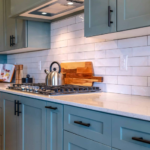A tub surround is more than just a bathroom accessory — it’s a functional design choice that protects your walls and elevates the look of your space. Whether you’re building a new bathroom or updating an old one, the right tub_surround can completely transform the room. Not only does it prevent water damage, but it also adds a clean, finished look to your bathtub area.
From tub_surround panels to full one piece tub_surround systems, there are options to suit every budget and style. In fact, many homeowners today are opting for surrounds made of acrylic, fiberglass, or even custom tile tub surround setups that match the overall aesthetic of their home.
Because choosing the right product can be overwhelming, we’ve put together this complete guide to help you navigate your options. Let’s dive in!
Types of Tub Surrounds: What Are Your Options?

1. One Piece Tub Surround

1. One Piece Tub Surround
This type is ideal for new constructions or full renovations where walls can be accessed easily. A one piece tub surround is a molded unit that includes three sides and the tub apron. Because it’s seamless, it offers excellent protection from water damage and is easy to clean.
2. Three-Piece or Multi-Piece Units
These are common for remodels. Made from acrylic or fiberglass, multi-piece tub_surround kits are easier to install in existing bathrooms because they can fit through doorways and be assembled in place.
3. Tile Tub Surround
For a luxurious, custom look, a tile tub_surround is a go-to option. It offers flexibility in design, allowing you to match your floor tiles or go bold with accent walls. However, keep in mind that tile requires more maintenance due to grout lines.
4. Acrylic Tub Surround
An acrylic tub_surround is lightweight, durable, and low-maintenance. It’s available in various colors and finishes, making it a favorite among homeowners who want modern style without the high cost.
5. Fiberglass Tub Surround
If you’re working with a tighter budget, a fiberglass tub_surround is a cost-effective solution. It’s not quite as durable as acrylic, but it still provides solid performance with minimal upkeep.
Benefits of Installing a Tub Surround
When you choose a tub_surround, you’re doing more than just protecting your walls — you’re investing in the functionality and longevity of your bathroom.
Here’s why it matters:
-
✅ Waterproof Protection: Prevents mold, mildew, and structural damage.
-
✅ Easy Maintenance: Most surfaces wipe clean with little effort.
-
✅ Quick Installation: Especially true with tub_surround kits.
-
✅ Style Upgrade: Adds a polished, cohesive look.
-
✅ Budget Flexibility: Ranges from basic to high-end finishes.
-
✅ Durability: With proper installation, your surround can last for decades.
Choosing the Right Material for Your Tub Surround
When selecting a tub_surround, your choice of material affects not only how it looks but how long it lasts and how much it costs.
| Material | Pros | Cons |
|---|---|---|
| Acrylic | Durable, glossy finish, easy to clean | More expensive than fiberglass |
| Fiberglass | Budget-friendly, lightweight | Less durable, can yellow over time |
| Tile | Highly customizable, upscale appearance | Labor-intensive, requires regular grout care |
| Solid Surface | Seamless, modern look | Expensive, professional installation needed |
Hot Tub Surround Ideas for Outdoor and Spa Areas
If you’re upgrading a hot tub_surround, the approach is slightly different from indoor bathrooms. Outdoor surrounds require weather-resistant materials and often double as entertainment areas.
Here are some popular hot tub surround ideas:
-
Wood Decking: Provides a natural, spa-like feel.
-
Stone or Concrete: Durable and stylish.
-
Composite Panels: Weatherproof and modern.
-
Built-in Benches: Great for seating and storage.
-
Privacy Screens: Adds elegance and intimacy.
No matter what your outdoor setup looks like, a functional and attractive hot tub surround can increase your enjoyment and the overall value of your property.
DIY Tub Surround Installation vs. Hiring a Pro
Installing a tub_surround kit yourself can save money, but it requires precision. A poorly installed surround can lead to leaks and costly damage. Here are your options:
DIY Installation:
-
Use prefabricated tub surround panels for easier alignment.
-
Be sure to level and seal everything with waterproof caulking.
-
Follow manufacturer instructions carefully.
Hiring a Professional:
-
Ideal for tile or one piece tub_surround units.
-
Ensures proper waterproofing and secure fittings.
-
Comes with a workmanship warranty in many cases.
Cost Breakdown: What to Expect
 The price of a tub_surround depends on the material, size, and whether you’re doing the installation yourself.
The price of a tub_surround depends on the material, size, and whether you’re doing the installation yourself.
| Surround Type | Cost Range (Materials Only) |
|---|---|
| Fiberglass Kit | $100 – $300 |
| Acrylic Surround | $300 – $600 |
| Tile Tub Surround | $800 – $2000+ |
| One Piece Unit | $400 – $1000 |
| Custom Hot Tub Surround | $1000 – $5000+ |
Installation adds an extra $500–$1500 depending on complexity.
Maintenance Tips for Long-Lasting Tub Surrounds
🧼 clean with non-abrasive cleaners to preserve the original shine and finish.
🧽 avoid harsh scrubbers, as they can easily scratch surfaces like acrylic or fiberglass.
💧 reseal grout lines (especially for tile tub surrounds) at least once a year to prevent water damage and mildew buildup.
🔧 check caulking regularly for signs of cracking, peeling, or mold growth, and replace it immediately if needed.
Staying consistent with these maintenance steps will ensure your tub surround not only looks beautiful but also performs effectively for many years.
Common Mistakes to Avoid
While installing or choosing a bath tub surround, steer clear of these common errors:
-
❌ Skipping waterproof backing boards (especially with tile)
-
❌ Using regular caulk instead of mildew-resistant options
-
❌ Poor sealing between panels
-
❌ Choosing low-quality materials to cut costs
-
❌ Ignoring manufacturer guidelines
By keeping these mistakes in mind, you’ll protect both your investment and your bathroom.
Author Bio Table
| Author | Bathroom Interior Writer – HomeStyle Hub |
|---|---|
| Specialization | Bathroom design, DIY renovations, home improvement |
| Experience | 8+ years in interior writing and renovation guidance |
| Published On | April 2025 |
| Social | @HomeStyleExpert on Twitter / homestylehub.com |
Final Thoughts
A tub_surround is one of those bathroom upgrades that blends form with function. It protects your space from moisture, adds visual appeal, and can even improve your home’s resale value. With options ranging from fiberglass tub_surround kits to luxury tile tub_surround designs, there’s something for every taste and budget.
Whether you’re dreaming of spa-like hot tub_surround ideas or just need to replace aging bath tub_surround panels, this is an upgrade worth considering. Choose the right material, decide if DIY or professional help is best, and take the leap. Your bathroom will thank you.
FAQs
What is the best material for a tub surround?
Acrylic and fiberglass are popular for affordability and ease of cleaning, while tile offers a custom, upscale look.
How long does a tub surround last?
With proper care, a tub_surround can last 15–30 years depending on the material.
Can I install a tub surround myself?
Yes, many tub_surround kits are designed for DIY installation. However, complex jobs or tile work may need a professional.
How much does it cost to replace a tub surround?
Costs range from $300 to over $2000, depending on material and whether you install it yourself or hire someone.
Are tub surrounds waterproof?
Yes, when installed properly, tub_surrounds create a watertight barrier that protects your walls from moisture.






